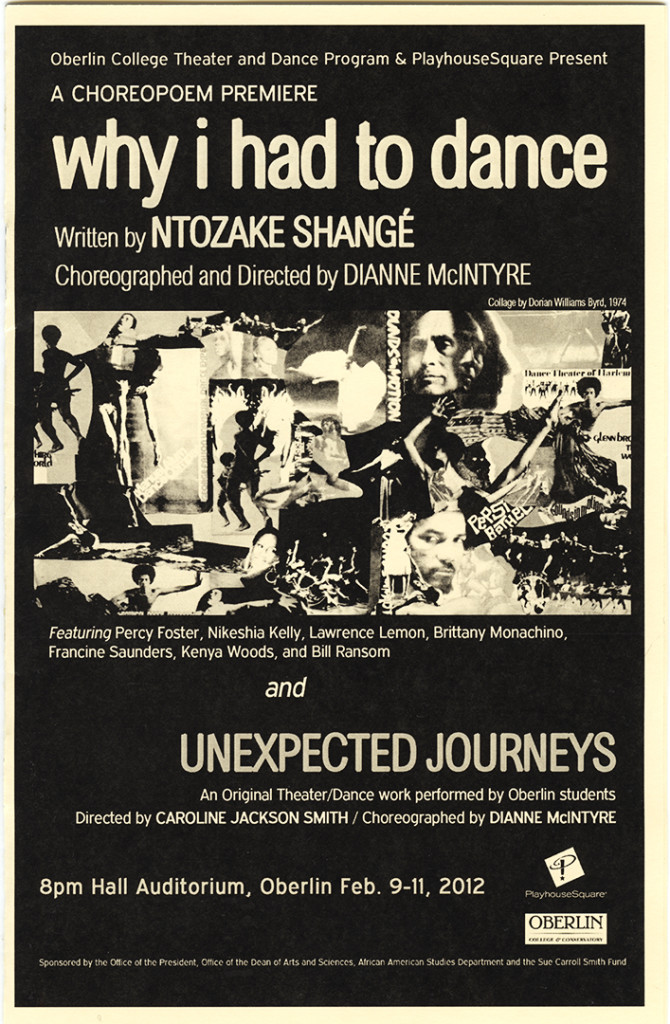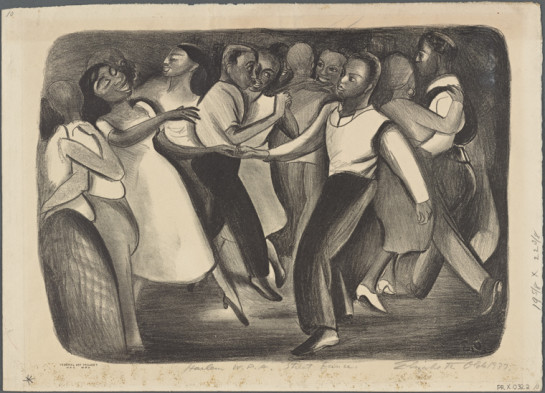Dianne McIntyre and Black Performance Art
NICOLE HINES

Ntozake Shange Papers, Barnard Archives and Special Collections, Barnard College
“there was a dance that was a black dance/ that’s what it means that black folks cd dance/ it dont mean we got rhythm/…it dont mean just what we do all the time/ it’s how we remember what cannot be said”
(Lost in Language & Sound, 68)
Dianne McIntyre, dancer, choreographer and founder of the Sounds in Motion dance company and school has been influential in the world of performing arts. Inspired by the theories of the Black Arts Movement that called for arts that did political and cultural work, McIntyre collaborated with various jazz musicians and writers on productions that promoted consciousness. These collaborations often included live jazz, dance and spoken word.
According to Ntozake Shange, one of McIntyre’s collaborators, for the performing arts to be successful at impacting an audience, its form has to represent culture. Shange argues in much of her writing that in order for black performance art to be meaningful, language, dance and music must be in constant conversation. Language, dance, and music are the most successful when they inform and inspire each other. McIntyre is often described as being responsible for combining art forms that are historically separated: music being characterized as masculine and of the mind, and dance being characterized as feminine and of the body. McIntyre’s work not only allowed dancers to be seen but also heard through their collaboration with jazz artists.

Ntozake Shange Papers, Barnard Archives and Special Collections, Barnard College
“I want the dance to have some kind of meaning, some kind of impact on myself, the dances, and the people who experience it, so that it has some function. I know the dances in Africa are so connected to the people in terms of their society, their daily life. In that same way, I want the dance to have a close connection with what people’s lives are about. Because of that the themes I select often deal with our history and whatever we feel from the inside in our daily lives”
(Dianne McIntyre in African Dance, 131)
What initially intrigued me about Dianne McIntyre was her participation in what Joni L. Jones has called the “theatrical jazz aesthetic,” which emerged in the 1970s (Jones, 598). Many black artists who participated in experimental works were not widely supported by the larger Black Arts Movement of the time. McIntyre’s company Sounds in Motion became the creative workshop for a group of famous performance artists. This “theatrical jazz movement,” while participating in and being inspired by the Black Arts Movement, did not pronounce the strident nationalism of the group. The “theatrical jazz movement” was characterized by a combination of movement, music and spoken word, and was often lead by women. The movement also applied many of the characteristics of jazz music to all of its components. The theatrical jazz aesthetic “borrows many elements from the musical world of jazz—improvisation, process over product, ensemble synthesis, solo virtuosity—and disrupts the traditional conventions of Western theatre” (Jones, 599). On her method of borrowing, McIntyre says, “I tried to teach myself to move the way they [jazz musicians] sounded, and thereby expanding my vocabulary from that traditional modern dance that I had been taught” (Welsh-Ashante, 133).
Artist’s Statement
Dance is more about the process than the product. Black dance is an expression of culture and history and is therefore not a controlled product. Black dance moves. Products do not convey emotion and communicate experiences. The black dance of Dianne McIntyre’s time period was used to convey the black experience and provide the audiences with intimate moments, feelings, connections, and understandings. Her intention was to make the performance useful and provide everyone involved with something they needed. When dance is performed, it is ephemeral, it is about the experience of both the dancers and audience in the time that they spend in communion.
I was inspired by how both Shange and McIntyre used poetry as a way to inform movement and by doing so tell stories that are uniquely black. Following Dianne McIntyre’s example, I decided to create several phrases of movement inspired by different selections of music and quotes from Shange’s poetry. I was also inspired by a recent performance of McIntyre’s choreography performed by members of Dance Theater of Harlem’s company. The piece was entitled Change and premiered on February 2, 2016, and was inspired by black women and their commitment to progress. These phrases are meant to be a glimpse into the process of creating movement, and are, therefore, works in progress.
Phrase 1.
Music:
“Alabama” – John Coltrane
Language:
Phrase 2.
Music:
“Flat Backs in 3” – William Catanzaro
Language:
“dance frees the soul/ one generation/ to the next”
(Lost in Language & Sound, 53)
Phrase 3.
Music:
“In a Sentimental Mood” – John Coltrane
Language:
“Chants that must be sung, music that must be heard, to pacify spirits, consecrate our souls, we sometimes call magic”
(Lost in Langauge & Sound, 59)
